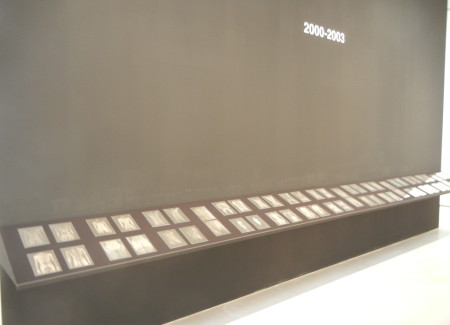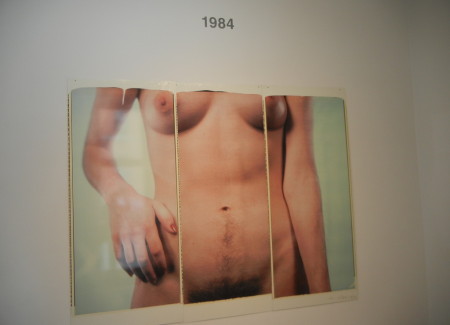JTF (just the facts): A total of 62 photographs (many diptychs and multi image works) and 1 painting, generally unframed and hung against white walls in a series of four interconnect rooms. 31 of the works are Polaroids mounted on aluminum; 19 are color and 12 are black and white, and they range from single images to as many as five panels. The individual panels range in size from 24×20 to 97×43 (the largest work measures 97×215 in total). The other 31 photographs are daguerrotypes, displayed under glass against a single black wall. These works are diptychs (arranged side by side or above one another), each panel sized roughly 9×7. The Polaroids were made between 1984 and 2014, while the daguerreotypes were made between 2000 and 2008. All of the works on view are unique. The single painting on display is acrylic on gessoed canvas, sized 117×254, from 1967. A catalog of the exhibit is available from the gallery for $40. (Installation shots below.)
Comments/Context: Chuck Close’s decades long relationship with portraiture is one of the cornerstones of post war American art, and in many ways, it’s an ongoing story of process evolution. Pick up any of the artist’s many exhibition catalogues and discussions of the differing painting and printmaking techniques he has employed will quickly come to the forefront. Using the human face as his baseline subject matter, he has experimented with a dizzying variety of processes and methods for breaking up, abstracting, and representing individual visual elements and features, from fingerprints and hand made paper discs to increasingly abstract squiggles, dots, and concentric circles of paint. Photography has continually been an integral part of these efforts, with large scale Polaroids used as intermediate states, the images gridded into meticulous squares to guide his overall process. And while there have been a number of recent exhibits of these photographic maquettes reconsidered as final product artworks, this show brings together several decades of purely photographic work, all of it centered on the nude form.
The single most exciting revelation to be found here is just how innovative Close has been over the years when approaching the genre of the nude with a camera. He has experimented with male and female models, black and white and color imagery, monumentally large and intimately small prints, modern Polaroid processes and antique daguerreotypes, young lithe bodies and older sagging ones, single frames and multi-panel sets, and compositional alternatives from tightly cropped torsos to full length forms. Seen with the benefit of hindsight, it’s as though he methodically charted out all of the exponential possibilities years ago, and has spent the intervening time slowly working through the list and trying out the most promising combinations.
The earliest photographs on view come from the mid 1980s and show Close exploring the limits of massive, towering scale. Paired with a late 1960s monochrome painting that addressed many of the same issues, the color photographs confront us with larger than life size hugeness, delivering photographic realism with a jolt of unexpected aggressiveness. We’re dwarfed by flesh, and forced to contend with it as an imposing, space-filling physical force.
Close returned to the photographic nude in the late 1990s, this time making moderately sized color Polaroids of cropped torsos, either as single works or as front and back diptychs. Set against dark backgrounds, the bodies are made anonymous and sculptural, like classical statues with missing heads and limbs. Nuances of musculature and curved edge silhouettes draw our attention, arms pulled above heads to avoid distraction, or allowed to fall and become another subtlety to investigate.
Having optimized this set of poses, Close then reconsidered his process in the early 2000s, reviving the daguerreotype and bringing an alternative sense of hold-in-your-hands immediacy to the works. When these nudes first appeared, they felt almost revolutionary; no one had ever used this silvery antique process to depict such modern nudes before, and their up close clarity was entrancing. The torsos (both male and female) float in tactile darkness, their curves given a hint of three dimensionality amid the imperfection exposing and often astonishing detail inherent to the process. Given their small size and the way the light interacts with the surface of the object, these nudes require a more personal kind of interaction, like the sharing (or exposing) of a secret. Sadly, this particular installation arrays them in a cavernous space with inopportune lighting, so that special feeling is diminished considerably; given a different setting, they should have been much more mysterious and elusive.
The most recent works on view find Close having returned to his Polaroid camera, but now exploring full body nudes complete with faces. These works are mid sized (but smaller than life sized) front and back diptychs, alternately in black and white and color, and generally depict younger (and fitter) models. Nuances of skin tone and hair are the new defining features (especially in black and white), shaved heads and tangles of long curly locks moving the bodies from idealized muscled forms to actual people, with arm positions often giving away a sitter’s level of comfort; even a small twist of the hips can reveal a bit of confident swagger.
Ultimately, this show is effective because it allows us to follow Close’s iterative approach to artistic thinking, where certain variables are held constant while others are allowed to change. While not every combination is equally successful, it’s hard not to be impressed by the rigor and thoughtfulness being applied to the task. The longer he keeps looking at faces and bodies, the more new ideas he seems to generate, partially due to his mastery of materials and processes and his willingness to adapt them to new constructs. While there are plenty of bodies on the walls here, what is really on view is Close’s creative mind, and his methodical approach to expanding his ability to see.
Collector’s POV: The works in this show are priced as follows. The largest of the multi-part Polaroid photographs range in price from $200000 to $500000. The single image Polaroids are $50000 each, while the various diptychs are either $80000 or $90000 each; the daguerreotypes are $45000 each. The single painting is NFS. Close’s photographs have become more consistently available in the secondary markets in recent years, with prices ranging between roughly $2000 (works in large editions) and $300000 (generally large multi-part works).















